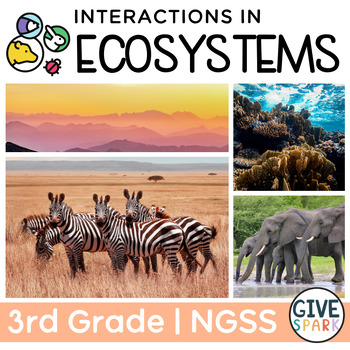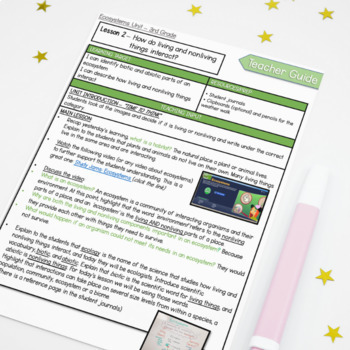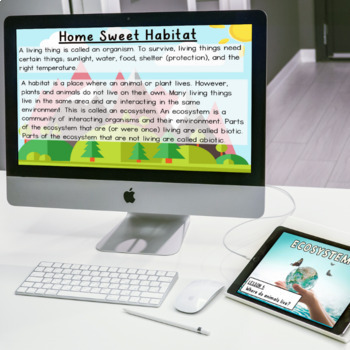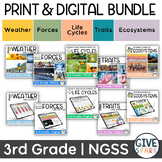3rd Grade NGSS Science Unit: Ecosystems - Interactions, Energy and Dynamics
- Zip
What educators are saying
Also included in
- 3rd Grade - NGSS Science Bundle - YEAR LONG Curriculum - FIVE UnitsWelcome to the ultimate science teaching solution for 3rd grade educators - the 3rd Grade Science Super Bundle. This all-inclusive package is specially designed to ignite curiosity, enhance understanding, and fuel the passion for sciPrice $69.75Original Price $79.75Save $10.00
- Third Grade NGSS: The Ultimate Teaching Bundle – Print & Digital!Get ready for an exciting science journey with this all-in-one bundle, perfect for third-grade teachers. This package includes FIVE highly engaging science units, all aligned with the NGSS standards. In this package, you will receiPrice $110.00Original Price $144.75Save $34.75
- Ecosystems - Third Grade Science BUNDLE | Print + Digital NGSSThis comprehensive bundle unit is specifically designed for third-grade students to learn about the topic of Ecosystems.Standards Alignment:The unit consists of 12 engaging lessons that incorporate hands-on activities. It is fully alignedPrice $22.50Original Price $28.95Save $6.45
Description
3rd Grade NGSS Science Unit: Ecosystems - Interactions, Energy and Dynamics
Overview: Delve into the dynamic world of ecosystems with this comprehensive science unit tailored for third-grade learners, suitable for both classroom and homeschool environments. This unit includes 12 engaging lessons featuring PowerPoint presentations, detailed lesson plans, and interactive student journals, exploring how living and non-living things interact within various ecosystems.
NGSS Alignment:
- NGSS.3-LS4-1: Analyze and interpret data from fossils to provide evidence of the organisms and the environments in which they lived long ago.
- NGSS.3-LS2-1: Develop a model to describe the roles of producers, consumers, and decomposers in a community and the flow of energy and matter through ecosystems.
- NGSS.3-LS4-3: Construct an argument with evidence that in a particular habitat some organisms can survive well, some survive less well, and some cannot survive at all.
- NGSS.3-LS4-2: Use evidence to construct an explanation for how the variations in characteristics among individuals of the same species may provide advantages in surviving, finding mates, and reproducing.
- NGSS.3-LS4-4: Make a claim about the merit of a solution to a problem caused when the environment changes and how it affects organisms living there.
Approach to Learning:
- Interactive and hands-on: Students participate in labs, experiments, and hands-on activities that make ecological concepts tangible and engaging.
- Connection to Prior Knowledge: Lessons are designed to connect with and expand upon students' existing knowledge of natural environments.
- Focus on Inquiry: Encourages students to explore ecological questions and scenarios, fostering a deeper understanding and curiosity about natural world interactions.
What’s Covered?
- Lesson 1: Exploring Habitats
- Lesson 2: Interactions Between Biotic and Abiotic Factors
- Lesson 3: Energy Transfer in Ecosystems (Food Chains)
- Lesson 4: Social Structures in Animal Groups
- Lesson 5: Disease Spread in Populations
- Lesson 6: Habitat-Specific Animal and Plant Adaptations
- Lesson 7: Structural Adaptations in Arctic Animals
- Lesson 8: Behavioral Adaptations and Migration
- Lesson 9: Variations Within Species
- Lesson 10: Survival Impact of Genetic Variation
- Lesson 11: Learning from Extinct Animals and Fossils
- Lesson 12: Insights from Fossil Studies
End of Unit Project:
"I Speak for the Trees!" (The Lorax-themed project): Students engage in a collaborative, problem-solving task to design the ultimate habitat for unusual, whimsical creatures, applying their learned knowledge from the unit. This project inspires creativity and practical application of ecological principles.
What's Included in Your Download?
- Engaging Lesson Plans: Dive into 12 meticulously structured lesson plans, complete with vibrant teaching presentations available as PowerPoint and Google Slides and interactive student journals, designed to captivate and educate third-grade learners.
- Comprehensive Educational Resources: Gain access to a rich array of teaching aids, including detailed guides, visually appealing vocabulary posters, and hands-on lab activities. Enhance understanding with targeted reading comprehension tasks, and measure learning with ready-to-use assessments, all tailored to deepen knowledge of ecosystems.
- Innovative End-of-Unit Project: Engage students with the "I Speak for the Trees!" project, a creative and collaborative task inspired by the whimsical world of Dr. Seuss. This project includes all necessary materials and instructions, challenging students to apply their ecological knowledge in designing sustainable habitats.
- Robust Assessment Tools: Evaluate student progress effectively with a mix of formative and summative assessments. Comprehensive answer keys are provided to streamline grading and feedback, ensuring an efficient and rewarding teaching experience.
Need Help? Before leaving feedback:
- Email: givesparkco@gmail.com
- Submit a Help Ticket
- Ask a Question on the Q&A Tab
Thank You! We appreciate your interest in our resources. For a detailed preview of each unit, please download the individual previews.
Warm regards,
Vicky - Founder of Give Spark
Terms of Use: © Give Spark, PTE Ltd. This product is for use in one classroom only and is protected by copyright laws. Redistribution or alteration without permission is prohibited.








